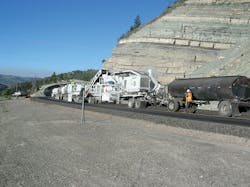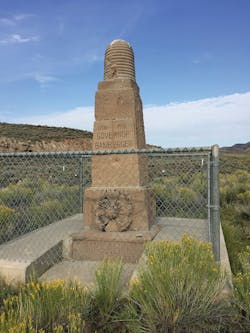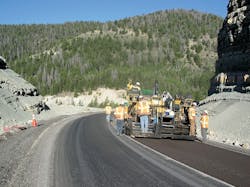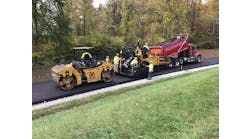By: Brian W. Budzynski
There’s not a whole ton of drama you can add to the story of a project that went according to plan.
While this is bad luck for a writer and his appetite for the most telling details, it is music to the ears of any road worker—and it played with deft symphonic resonance for the crews behind the U.S. 191 Indian Canyon restoration project outside Duchesne, Utah, one of this year’s Roads & Bridges/Asphalt Recycling and Reclaiming Association Recycling Award recipients.
“With the elevation and grades we were dealing with, it surprised everyone who worked on this project how quickly we got it done,” Stephen Steed, safety manager for Coughlin Co., the firm which performed the cold in-place (CIR) recycling on this project, told Roads & Bridges. “It was one of those kinds of jobs.”
Project specs called for 1 in. of existing asphalt to be milled off and placed on the shoulders.
A demanding stretch
With elevations beginning at 6,000 ft above sea level and topping out just over 9,100 ft, U.S. 191 is a 43.5-mile stretch of highway between the towns of Helper and Duchesne known as Indian Canyon that borders some unique landscapes. Mountains in one direction, desert in the other. The Utah Department of Transportation (UDOT) earmarked the entire corridor for rehabilitation, but its shifting topography, persistent remoteness and limited right-of-way precluded pretty much every paving option that came to mind. Consequently, it was decided that CIR was not only the correct option, it was really the only option.
Dave Gill, UDOT’s Region Three Pavement Management Engineer, described why the agency chose CIR. “The project was scoped for a cold in-place recycle because of three things: location, type of distress and traffic volumes,” Gill said. “The closest pit is in Duchesne, about 25 miles away. In addition, the closest asphalt plant is in Fruitland, approximately 25 miles west of Duchesne. The cost to mill out and haul the material that far would have been much more than what was available. The road had a lot of environmental cracking. Based on the cores, these cracks were full depth. To correct that, we would have needed to remove all the asphalt and replace it. Because the CIR retards the reflective cracking, we were able to remove the top inch, then recycle the next three, with the anticipated benefit of not having the cracks reflect through in six years. About 50% of the traffic on this section is trucks. By recycling the existing material in place, we were able to reduce the amount of time the contractor was on the road.”
Prior to this project, two previous CIR projects were completed on the roadway—the first on the south end of Indian Canyon on the Carbon County line, finishing up at the intersection of U.S. 6 west of Helper, and the second beginning a few miles south of Duchesne and finishing towards the Indian Canyon summit. This left the middle stretch, the most difficult portion.
“They saved this one for last as it was the most difficult due to elevation and grade, not to mention the tremendous amount of truck traffic it gets from the oil industry and from local fracking operations,” Steed said.
A memorial dedicated to former Utah Gov. Simon Bamberger along the project route.
Tight maneuvering
The entire project site offered very little in the way of reasonable staging areas, which would become a challenge to both Coughlin and to Burdick Materials, the project’s prime contractor, who would come in once the CIR was set and done and perform the wearing surface and chip seal work.
“We were working in a pretty confined area, right at the summit,” Steed said. “We had a parking area that trucks use to pull off and chain up in winter. That was our staging area. We had two slaker tanks for slaking lime, and we staged the emulsion tanks to run out to the train as needed. We had to have water hauled up from Duchesne by tanker.”
This, coupled with a tough traffic management scenario, meant crews were going to need to amp up their output if this project was going to not only maintain its schedule, but minimize to any degree possible its impact on the traveling public.
“That heavy truck traffic really was an extra issue,” Lee Goodrich of Burdick Materials told Roads & Bridges. “Getting the trucks started and stopped on these hills. The speed limit posted ranges from 55 mph at either end of the road to 35 mph toward the middle. A lot of it is oil industry crude haulers and a lot of fracking traffic picking up from the rail service, and this road’s also a freight route to get to Wyoming. UDOT would only allow Coughlin to close lanes for a maximum of 15 minutes at a stretch. And it’s always a challenge to pave up and down; you’re always in danger of having more variance with your density and compaction, the effectiveness of your rollers. You’ve got to adapt.”
The project specs called for 1 in. of existing asphalt to be milled off and placed on the shoulders. This lift was a chip seal, and recycling it was impractical because the oil in the seal would have thrown off the UDOT-mandated CIR mix. Three inches would be milled and recycled with an average of 2.7% engineered emulsion manufactured and supplied by Peak Asphalt (Western Emulsions) Woods Cross, Utah terminal.
The project specs prescribed by UDOT required a PG 58-34 material, rather than the more common 64-22 seen on CIR projects. “Prior to this we’d never done that before,” Jared Wright of Western Emulsion told Roads & Bridges. “We’d done a 58-28 or a 64-22. The unique thing about that is that other suppliers were telling us to tell UDOT no, that we couldn’t do it. But we made some lab design samples to prove we in fact could do it, and then we put in the bid for the job. It came back as really good material.”
The outer 6 in. of pavement were left in place to provide a confined edge for better compaction. Emulsion content was controlled by gradation and film thickness calculations. Lime slurry would be incorporated at the rate of 3% based on 1% lime solids and 2% water as an anti-stripping agent and to help with the curing process. Barney Trucking hauled the quicklime from Greymont’s Cricket Mountain plant near Delta, Utah. Water from the pre-mill, lime slurry and emulsion were balanced against the optimum compaction moisture (Proctor) to keep the mix properly hydrated for obtaining density. In this way, the green mixture was treated like untreated base course for initial rolling.
Time was of the essence, and Coughlin found that an ounce of preparation meant nearly an extra lane-mile of progress each day.
“Two miles per day is usual,” Steed said, “but in this case we did more, closer to 3 miles per day, which contributed to us finishing up earlier than scheduled. We did one complete side and then turned everything around and came back, the northbound lane then the southbound lane. Traffic can go back on at the end of the day, when the compaction results are in, within two hours of shutdown, usually. So that worked out well.”
Burdock finished paving operations on the U.S. 191 Indian Canyon project using a Cat 1055D paver with a Barber Green BG 360 pickup machine.
Getting it done
Coughlin dispatched three Roadtec RX 900 Rotomills on this project. One would grind off an inch of chip seal, with another tasked to perform widening and pulverizing in front of the recycling train. Two were equipped with 7-ft cutters, while the recycling Rotomill with a 12.5-ft cutter allowed for processing a 3-in.-deep, full-lane width in a single pass. A Roadtec RT-500 recycler unit with onboard screening, crushing and mixing capabilities was used to process the reclaimed asphalt millings.
“We finished up 2-3 days ahead of schedule,” Steed said, “which helped Burdick get down to the overlays and UDOT to do the testing and evaluations.”
After giving a week for the CIR to sit and cure, Burdick accomplished its paving operations—a 1.5-in. lift of hot-mix using a PG 64-34 binder with a ½-in. Superpave aggregate that included 25% RAP, with a subsequent chip seal for the final wearing course—using a Cat 1055D paver with a Barber Green BG 360 pickup machine. Compaction efforts included three Cat CB 63 steel double-drum and one Cat PC 360 pneumatic roller to button things up. The target for compaction density was an average of 92% with no allowable values below 90% of theoretical density. Final densities generally fell above 94% of the average daily Rice density, leaving no repair areas when all was said and done.
Burdick Paving Supervisor Kenny Gill commented that “this material was exceptional, and I wouldn’t hesitate to do another job like this again.”
“We didn’t have to make any adjustments to the emulsion, and Coughlin’s work was spot-on,” Wright echoed. “This might be the best-looking CIR job I have ever seen. It was a pleasure to be part of its success.”
About The Author: Budzynski is managing editor of Roads & Bridges.






